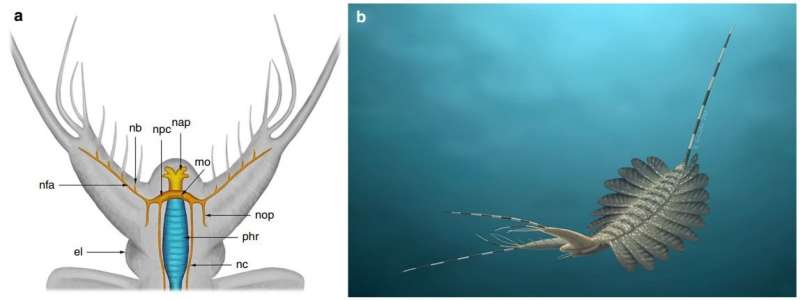March 19, 2018 report
Fossilized brains of ancient sea creatures found in northern Greenland

A team of researchers from Korea, the U.K. and Denmark has found fossilized brains of sea creatures that lived during the Cambrian explosion. In their paper published in the journal Nature Communications, the group describes features of the brains and why they believe their findings may overturn a commonly held belief about the ancestry of panarthropods and invertebrate panarthropods and also vertebrates.
The fossils are from Kerygmachela kierkegaardi, a type of sea creature that lived from approximately 521 to 514 million years ago. The creatures were approximately 25 centimeters in length, had large eyes and had 11 feather-shaped swimming flaps on their sides. They also had a long, thin tail, long twin appendages on their round heads, which they apparently used for grasping prey, and, as this new evidence shows, a single-segment brain. It is the brain that is newsworthy in this new effort—prior fossilized samples of Kerygmachela have been found before, but this is the first time that fossilized brains have been uncovered. The fossilized brains, the team notes, are made of thin carbon films.
The team reports that they found 15 fossilized brains in all, some of which also had associated fossilized nervous system tissue. Because the brains had just one segment, it is assumed that they were less complex than those with three segments, suggesting limited behavioral attributes. These findings call into question the assumption that the common ancestor of all arthropods and vertebrates had three-segmented brains. But, the team also notes, despite having just one segment, the creature clearly had enough brain power to survive during the Cambrian explosion. They also note that the creature's large eyes represent an intermediate evolutionary step between creatures with very simple eyes and those with eyes that are far more complex.
The fossils were located at a site named Sirius Passet on the northern tip of Greenland. The researchers found them by canvassing shale plots on land and using hammers to crack apart layers of shale which had protected the fossils from the elements over millions of years, allowing for the preservation of the fossilize brains. The fossilized brains represent some of the oldest ever found.
More information: Tae-Yoon S. Park et al. Brain and eyes of Kerygmachela reveal protocerebral ancestry of the panarthropod head, Nature Communications (2018). DOI: 10.1038/s41467-018-03464-w
Abstract
Recent discoveries of fossil nervous tissue in Cambrian fossils have allowed researchers to trace the origin and evolution of the complex arthropod head and brain based on stem groups close to the origin of the clade, rather than on extant, highly derived members. Here we show that Kerygmachela from Sirius Passet, North Greenland, a primitive stem-group euarthropod, exhibits a diminutive (protocerebral) brain that innervates both the eyes and frontal appendages. It has been surmised, based on developmental evidence, that the ancestor of vertebrates and arthropods had a tripartite brain, which is refuted by the fossil evidence presented here. Furthermore, based on the discovery of eyes in Kerygmachela, we suggest that the complex compound eyes in arthropods evolved from simple ocelli, present in onychophorans and tardigrades, rather than through the incorporation of a set of modified limbs.
Journal information: Nature Communications
© 2018 Phys.org





















